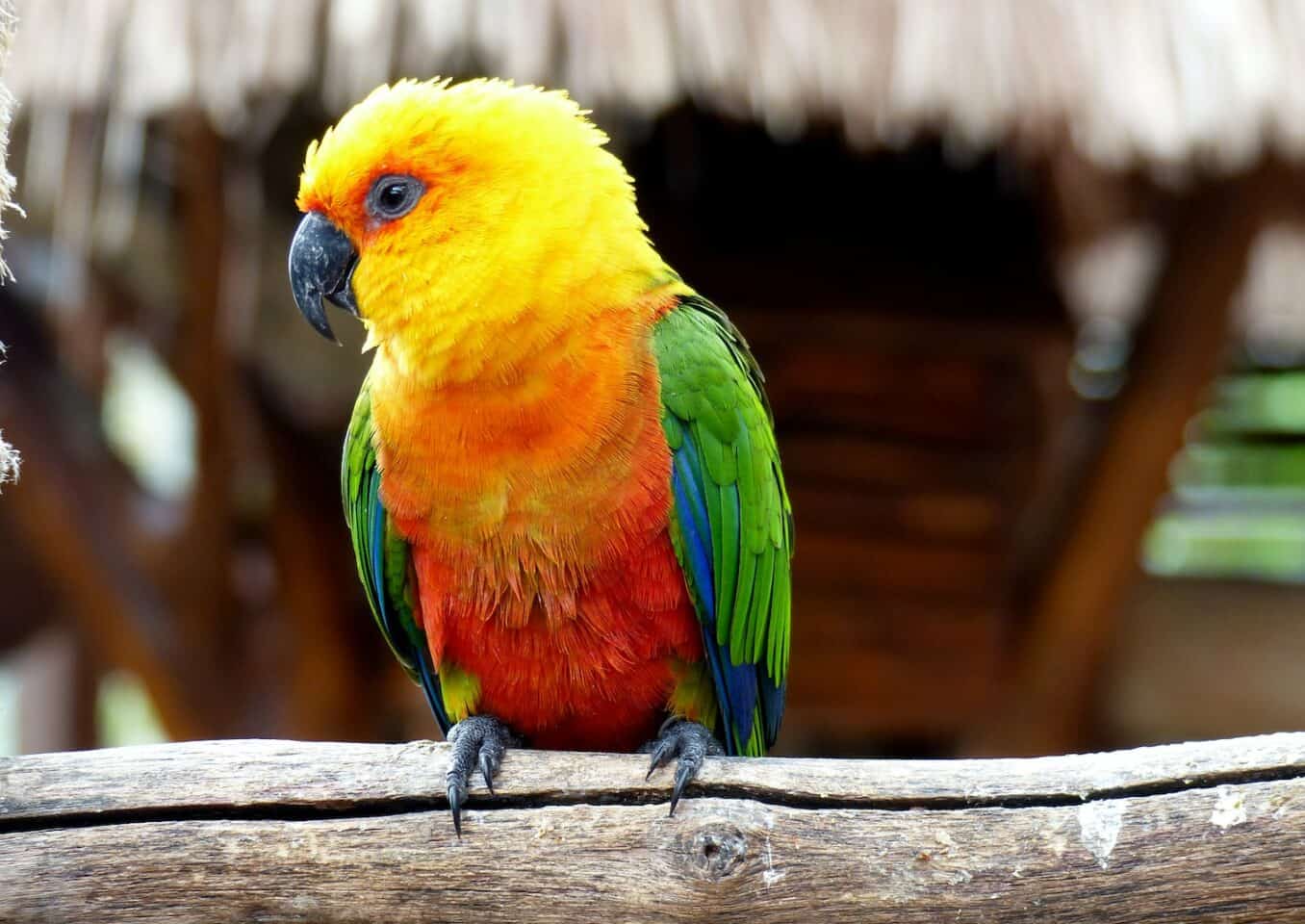Conures make delightful pets… because they are so affectionate and comical!
The conure parrot is a remarkable bird. They are popular because of their beauty, as well as their intelligence. They are often full of playful antics and they enjoy sharing their play. They are quite peaceful but will readily engage in play with human companions, other birds, and sometimes even other pets.
Besides being very social and quite active, conures are easily tamed. These little parrots love to learn tricks. Most conures can learn a few words though their voices are high pitched. Consequently what they are saying is often unclear. They are hardy birds that rarely get sick.
Both male conures and female conures make equally good pets. A conure parrot that is kept singly will tame quickly and will soon learn new tricks. They like affection and they also like to preen, and be preened. You’ll find that a conure parrot will just enjoy your company in general.
- See different types of conures in the Conure Family Varieties
Distribution
The conure parrots natural habitats range from Mexico and Central America to the Caribbean Islands and South America. The history of conures has been wrought with changes. Today many of the wild species are becoming scarce and some are on the brink of extinction.
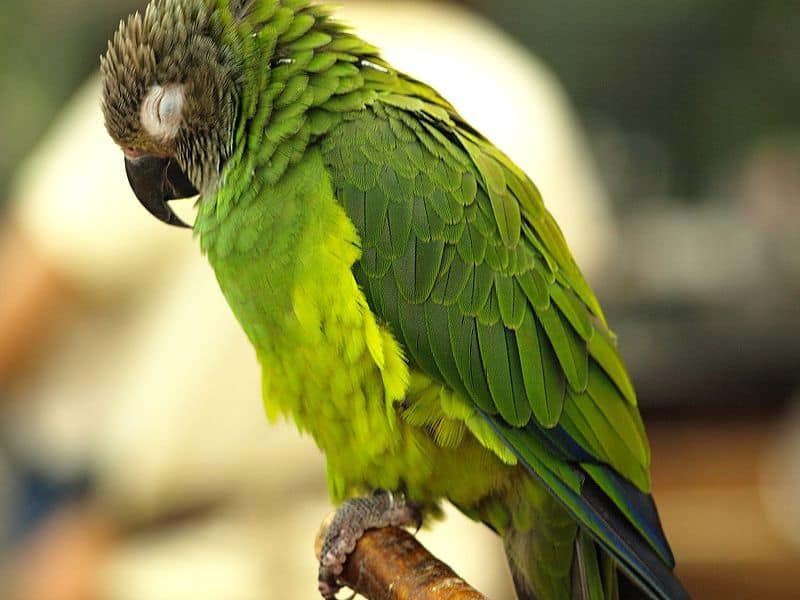
Description
The conures come from a very large and diverse group of parrots. But there are some generalities shared by all types of conures:
Conure Sizes
Conures come in many sizes. They are small to medium size parrots. They range in size from the largest, which is the Patagonian conure that gets up to about 19 inches, down to the painted variety that is only about 9 inches.
Conure Colors
Colors range from lush greens to brilliant yellow, reds and oranges, and into the whites and browns.
Conure Shape
Conures have slender bodies with tapered graduated tails. Some varieties have short tails that become narrow at the tip, while others have long, slender tails. They have broad heavy beaks of black or light horn color and a fairly broad cere at the base of the beak. Almost all have a clearly defined eye ring, with the females generally having a somewhat narrower ring than the males.
Conure Song
Conures have a harsh screech, rather than a gentle chirp. For some conures this may temper with time, or it may temper as they become comfortable in their surroundings.
There are many conure species, and a wide variety can be found in the pet industry. The types of Conures, along with some conure species that are commonly available include:
Aratinga Conures:
Many conures belong in the genus Aratinga. In this genus, there is some disagreement among ornithologists as to the number of species and subspecies, it ranges between 15 to 21 species and 55 to 57 subspecies.
Some of these familiar conure species are:
- Sun Conure
- Nanday Conure
- Jenday Conure
- Blue-crown Conure
- Dusky Conure
- White-eyed Conure
- Mitred Conure
- Half-Moon Conure (Orange-fronted conure)
- Golden-capped Conure
- Queen of Bavaria Conure (Golden Conure)
- Peach-fronted Conure
- Red-masked Conure
- Aztec Conure
Brotogeris Conures
In the genus Brotogeris there are 7 species and 15 subspecies, including the Grey-cheeked Parakeet and the Canary-winged Parakeet. Depending on the source, the Brotogeris genus will often be included under parakeets rather than under conures.
Enicognathus Conures
The genus Enicognathus has two species, and a few subspecies. Some of these familiar conure species are:
- Slender-bill Conure
- Astral Conure
- Chilean Conure
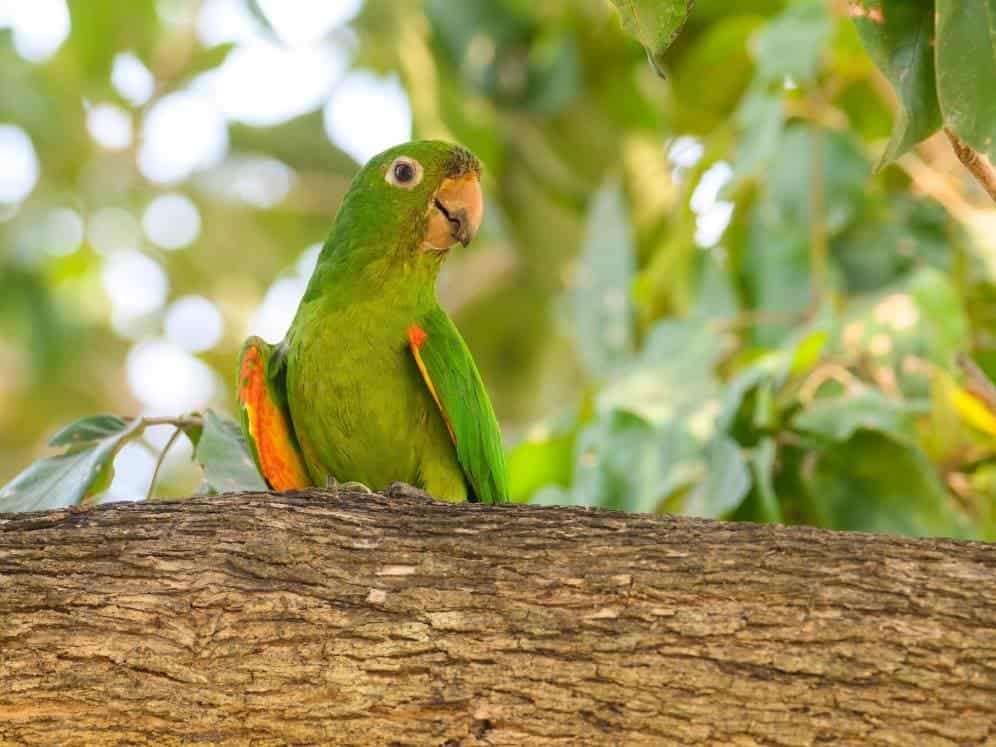
Cyanoliseus Conures
The genus Cyanoliseus has one species with three subspecies. This is a popular conure species:
Pyrrhura Conures
Lastly, in the genus Pyrrhura, there are 18 species and 37 subspecies. Some of these conure species are:
- Green-cheeked Conure
- Black-capped Conure
- Pearly Conure
- Souance Conure
There are two endangered conure species at present, the Queen of Bavaria or Golden Conure Aratinga guarouba from northern Brazil and the Blue-throated Conure Pyrrhura cruentata.
Bird Food
Foods available for Conures include formulated diets, either pelleted or extruded, seed only diets, and small parrot mixes which offer a mixture of both. There are pros and cons to feeding only a formulated diet as well as feeding only a seed diet.
Formulated Diet
A formulated diet provides a good nutritional base so does not require the addition of vitamins. However, it does not contain the phytonutrients (antioxidant pigments) that are found in vegetables, fruits, grains, and seeds.
Phytonutrients are believed to boost the immune system, help a body to heal itself, and to prevent some diseases. Also, conures can become bored with formulated diet due to the lack of variety.
Seed Diet
A seed only diet offers much more variety but requires additional vitamin and calcium supplements. Conures need not only nutritional requirements met but also variety for psychological enrichment.
A conure’s diet consisting of a good small parrot mix which is supplemented with various fruits, green foods, millet spray, and occasionally some mealworms is generally regarded as suitable.
Supplements
Supplemental foods include apples, grapes, many garden vegetables such as spinach, watercress, field lettuce, poppy, chickweed, dandelions, carrots, corn on the cob, peas, endive, and sweet potatoes, peanuts, monkey chow, and even dog food. Do not feed avocado as it is toxic to birds! A cuttlebone, or gravel and oyster shell, can be provided in a separate dish.
Additional proteins can be offered such as cottage cheese, hard-boiled eggs, peanuts, monkey chow, and even dog food. Vitamins can be added, either to the drinking water or the food.
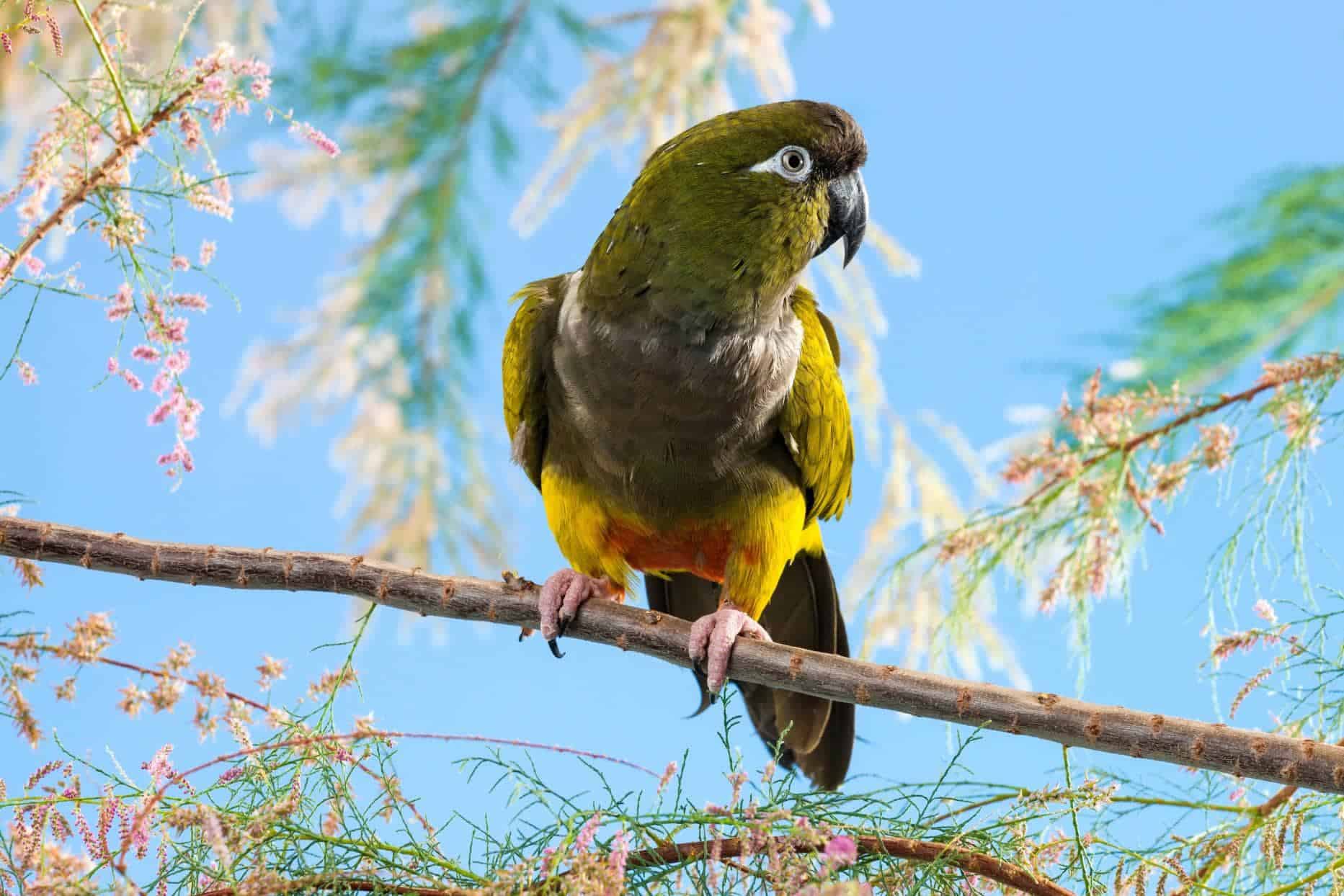
Water
Give your conure fresh drinking water every day. You can also add soluble vitamins and minerals to the water.
Bird Baths
Your conure will enjoy a bath! The personal hygiene of your conure includes a morning bath to keep their plumage glossy and beautiful. Use either a flat earthenware dish that your bird can step into and use its beak to throw water on itself. Or you can spray your bird with a light mist of lukewarm water.It may very well open it’s wings up to get a complete bath if you use the spraying method.
There will be a lot of preening after its bath! This is where your conure will reach with its beak down to the oil gland at the end of its body, using the oil to lubricate its feathers and end up with a beautiful sheen.
Bird Grooming
The wings should be kept trim if you want to discourage flight and to prevent the loss of your pet through an open window or door.
Conures generally maintain their nails and beaks pretty well on their own through climbing and chewing. There are many mineral blocks, lava blocks, and other beak grooming items available at your pet store to help your bird keep its beak in shape. However, both the nails and the beak should be trimmed if they get overgrown.
- You can find bird seed, bird cages, and everything you need for your pet here: Bird Supplies
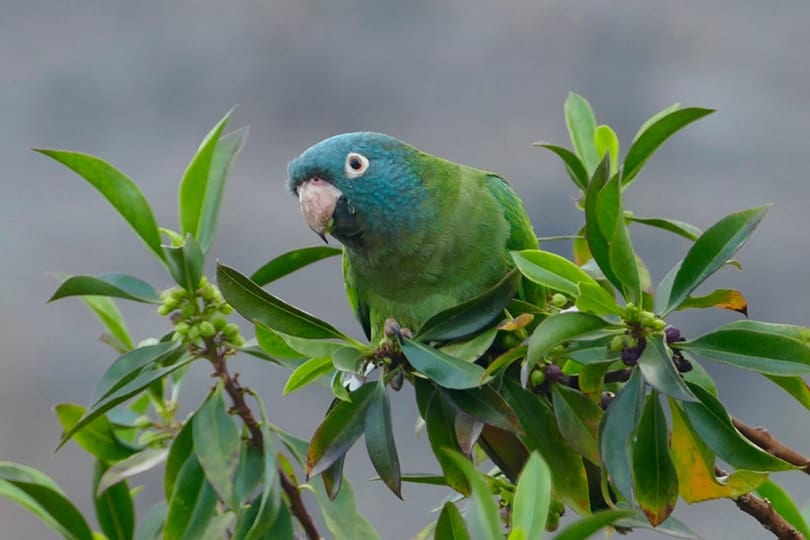
Care and feeding
Conures are much more sedentary in captivity than in the wild so their diet should be somewhat restricted. In the wild they feed mainly on grass seeds, nuts, berries, fruits, flowers, buds, insects and grains.
Housing
Bird Cages
Conures love roomy cages! A cage best suited for a conure must be large enough that the tail does not touch the bottom, and the bird has enough room for unrestricted movements.
For a small size conure, a minimum of 24″x16″x20″ (60 x 40 x 50 cm), and for the larger species, a minimum of 44″x26″x40″ (120 x 65 x 100 cm). This will provide room for both horizontal exercise and vertical climbing.
Bird Perch
Provide two Perches, sized between 3/4″ to 1″ (2 – 2.5 cm). Place one up high for roosting and one low by the food, water, and gravel dishes. Natural perches from willow, poplar and fruit trees are good for the bird’s feet and for it’s beak. The gnawing it will do on the perches will also alleviate your pet’s boredom.
Where to Place Conure Cages
Place the cage where it will be away from harmful fumes and drafts. To provide you pet with a sense of security, you can cover the cage at night.
Aviary
An indoor aviary is a cage set up in a room. A bird room is an inside aviary with sand or corn cob covering a tiled floor. An outdoor or breeding aviary needs to have a protected shelter that can be heated and cooled where necessary. The ideal size of an aviary is a length which is 10 times the length of the bird and a width and height of 6′ (2m).
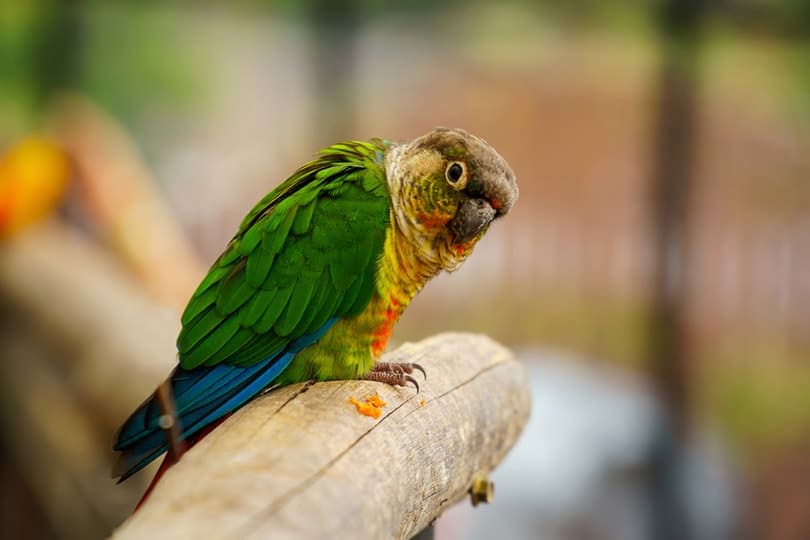
Maintenance
The basic cage care includes daily cleaning of the water and food dishes. Weekly you should wash all the perches and dirty toys. The floor should be lined with newspaper and changed daily, or covered with an absorbent bedding such as corn cobs or pine shavings and changed weekly. A total hosing down and disinfecting of an aviary should be done yearly, replacing anything that needs to be freshened, such as old dishes, toys and perches.
Social Behaviors
Conures are very friendly, peaceful birds. They live in flocks in the wild, and very seldom fight each other. It is this disposition that makes many of them very easy to finger train in just a few weeks in captivity.
Handling/Training
Always handle your pet conure gently. If a person is a afraid of a bird, the bird can sense this and it can make it impossible to develop a relationship. Never hit your bird or you will loose it’s trust, probably forever.
Taming Basics
To train you pet, the first thing you should do is have it’s wings clipped. A bathroom is a good area for working with your conure to train it. Be sure to cover the mirrors, have the windows closed and covered and the door closed.
Always reward good behavior and each success with loving praise and a treat. Some treats are a cracker, fruit such as a piece of grape, or a nut. Repeat the hand-taming lessons several times a day but for short periods of time, about 20 minutes a session.
Initial Training
Place the conure on a perch. If it insists on flying off, pick it up and replace it on the perch until it becomes use to the perch and is comfortable with it.
The next step is to take a second perch and gently push into your pet’s chest to encourage it to step up on it. Sometimes offering a treat to coax it up on the perch as it reaches for the treat will help.
Once it steps up without hesitation, you can then substitute your finger for the perch. If your conure tries to bite, you can blow on it and it will soon learn to behave.
Advanced Training
These are very bright birds and love learning tricks. Some of the tricks you can teach it to do are to play dead, lay on its back, and even pick up objects and bring them to you. Your conure can also learn to talk with patience and persistence.
For an extensive parrot training system that potentially turns your bird into a fun, loving companion as well as learning lots of cool tricks, try Chet Womach’s Parrot Training Course.
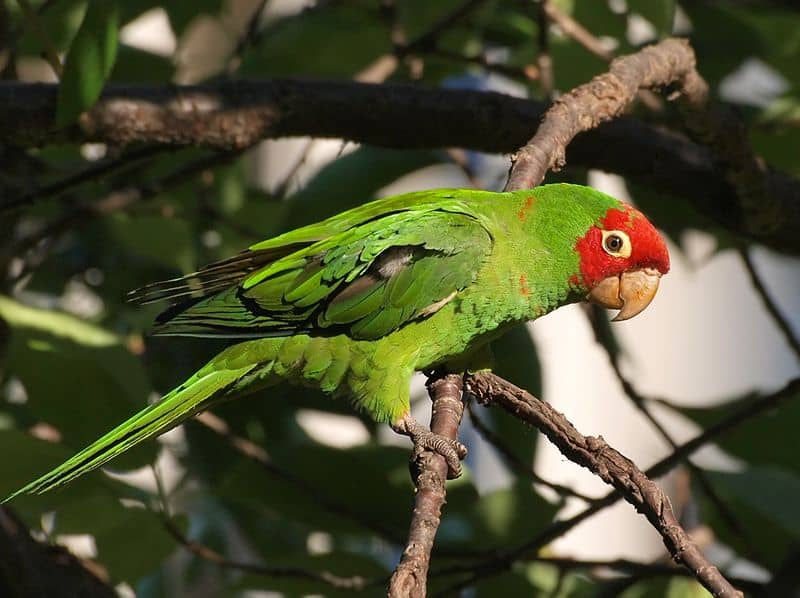
Activities
Conures need a great deal of exercise, and all conures are chewers. They must have distractions to keep them from becoming bored and lonely. Gnawing and climbing are great activities for this. They will generally chew up anything wooden! Natural perches and fresh twigs from willow, elder, poplar, and hawthorn work well
Other great toys include bells, ropes, swings, untreated leather, chew toys and ladders. They love mirrors and shiny unbreakable objects. Exercise and play are important activities for the physical well being and psychological health of your conure, but remember, they also need 10 – 12 hours of rest per day.
Breeding/Reproduction
Breeding conures is fairly easy. They must first adapt themselves to their environment before they will breed. Once they do breed, however, they will continue to breed year after year. Due to the destruction of their natural habitats, all conures shall ideally be breed in captivity to insure continuation of each species. Smaller conure species are ready to breed at 2 years and the larger at 3 1/2 to 4 years.
Breeding Conures
Though breeding conures is not very difficult, you must first determine their sex. Then you need to make sure you have a harmonious, bonded, pair.
Sexing Conures
The sex of most conures is difficult to determine by physical characteristics alone. Sexing conures is difficult even if you are an experienced breeder. Some things that can help include:
- Pelvic Bone: Sexing conures can sometimes be done by examining the pelvic bones. The pelvic bones may be closer together on a male than a female.
- Eye Coloring: In some conure species sex can be determined by iris coloring, with females having red while males have black. Read the description for your particular conure to find out if the adult male and female have different iris coloring.
- Feather Coloring: There are some conure species that the the sexes can be distinguished by differences in the coloration of their plumage. From the description of your particular conure, you can find out if the adult male and female have different colorings in their plumage.
- Testing for Sex: The sex on all others conure species must be determined by either a surgical probe, endoscopy, which can be done by many veterinarians. Sex can also be determined by a DNA testing, usually a blood sample or a few plucked feathers sent to be diagnosed in a lab. Or sex can be determined by a chromosomal analysis.
Breeding Environment
Conures will need a nest box placed up high that is filled 2/3’s full with pine shavings, peat, or other soft materials. Metal nesting boxes are nice as conures will often chew wooden ones. Pyrrhura conures and Aratinga conures can use a nesting box that is 12″x12″x12″ (30 x 30 x 30 cm). Humidity is best at between 50 – 55%.
Egg Laying and Hatchlings
After mating, the female conure will spend a lot of time in the box. When she starts laying, she will lay an egg about every other day until she has laid between 3 to 8 eggs. She will brood for approximately 27 days.
Baby conures will leave the nest when they are about 50 days old, give or take depending on the conure species.
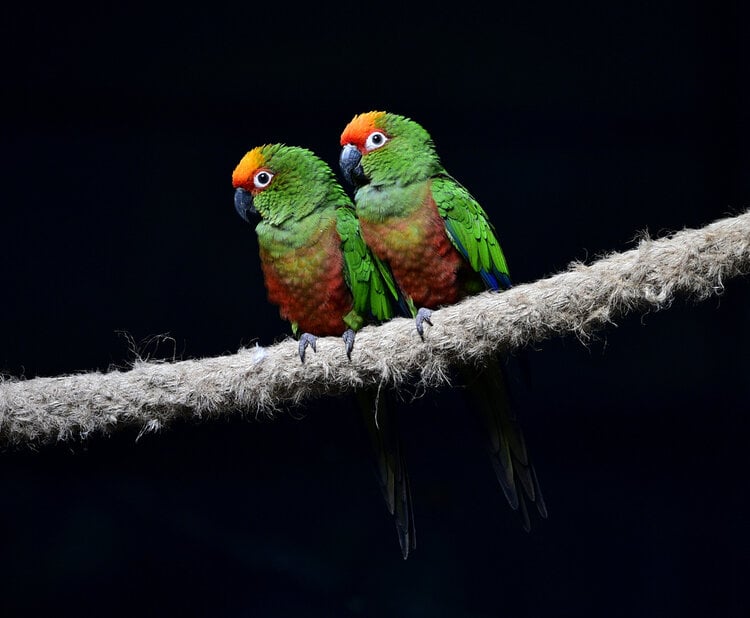
Potential Problems
Conure health is important and it helps to know signs of illness to watch for. Most conures are healthy, hardy birds. Kept under optimal conditions and fed a balanced diet, they are remarkably resistant to disease. As with all parrots, there are signs of illness to be aware to maintain optimum conure health.
Signs of illness include ruffled plumage, resting often with their head tucked under their wing or rump, not eating, discharge from the nostrils or mouth, cloudy eyes, loose watery droppings, weight loss (chest bone starts sticking out), large water intake, labored breathing, opening and closing it’s mouth, listlessness, perhaps sitting on the bottom of the cage, stops talking, and growths around the beak.
Some of the common illnesses your conure could contract are Aspergillosis – respiratory infection, Candidiasis, cold and sinus inflammations, diarrhea, egg binding, egg pecking, eye infections, feather plucking, frostbite, goiter or thyroid gland enlargement, mites, Pacheco’s Disease, psittacosis, Salmonella, worms. An ailing parrot should be taken to a avian veterinarian for diagnosis and treatment.
Behavior problems usually stem from something missing in the bird’s environment. Some birds are particularly vulnerable to feather plucking because of their intense need for socialization. Boredom, lack of trust, lack of interaction with other birds or people can lead to problems like biting, feather plucking, and screaming. Try to develop a bond of trust and spend time with your bird to help avoid these problems. We have also had good success with Chet Womach’s Parrot Training Course. He offers a free 3-day introductory course so you can try it out before you buy anything.
Availability
Due to successful breeding efforts, many of the more popular conure parrot species are very available in the pet industry. You should be able to find conures for sale from a pet store. You can also find conure for sale from bird breeders, bird farms, and often on-line. There are many hand fed baby conures becoming increasingly available.
Featured Image by: Annie Lang, Unsplash
